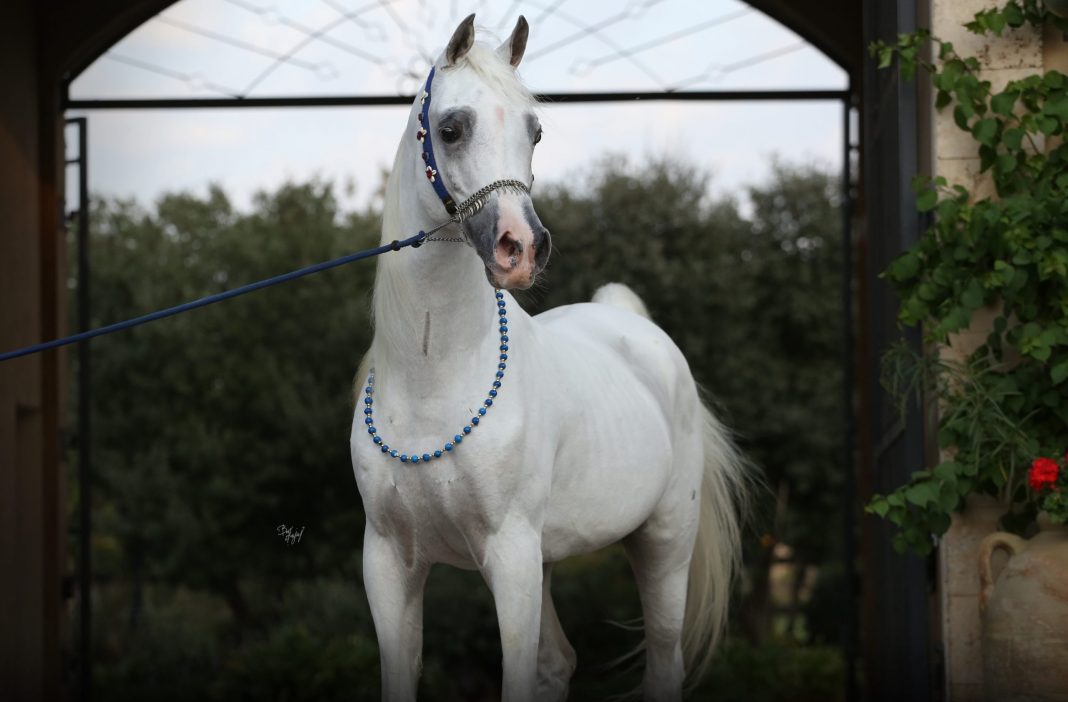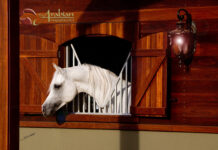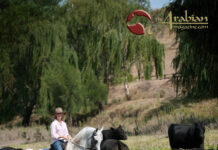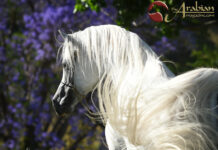This article first appeared in The Arabian Breeders’ Magazine April 2021, where we celebrated the amazing achievements of the straight Egyptian stallion, Laheeb, who sadly passed away the following March. One year on, we share this brilliant feature by Tzviah Idan, for as the title says, Laheeb’s flame still burns brightly. You can order a copy of this magazine, to enjoy the article in full, by clicking here. Photography unless stated by Bar Hajaj
In a world full of beautiful and exotic horses, there is only one Laheeb. He is one of those rare remarkable stallions that are simply ‘larger than life’ – not only stunningly beautiful, noble and charismatic, but also a tremendous sire of great significance worldwide. For many he embodies the very essence of the ideal Arabian horse and perfectly captures both its physical and spiritual qualities. Laheeb has just celebrated a milestone birthday, his twenty-fifth, making this a fitting occasion to look back and appreciate an amazing career and enduring legacy.
Foaled on 2 January 1996 at Ariela Arabians in Israel, Laheeb seemed born to be a star and was the farm’s first homebred to earn international acclaim. His sire needs little introduction – the highly decorated and universally acclaimed American-bred straight Egyptian stallion and Paris World Champion Imperial Imdal (Ansata Imperial x Dalia). Imperial Imdal spent three years at Ariela on lease and left his undeniable stamp not just on the Ariela herd but across the entirety of Israel’s then scant Arabian horse population.
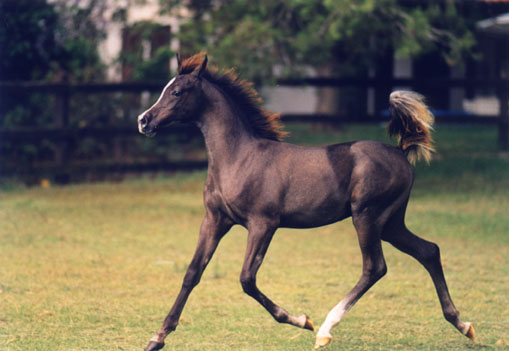
Laheeb as a foal 1996. Credit Van Lent
Laheeb’s dam was the celebrated American-bred straight Egyptian AK Latifa (Ibn Moniet el Nefous x Siralima), tracing back to El Dahma (Harkan x Aziza) through Bint Bint Sabbah (Baiyad x Bint Sabah), chosen and imported by the farm as a foundation mare, making Laheeb Dahman Shahwan in strain. He is strongly linebred on both the top and bottom of his pedigree to Morafic (ex Mabrouka by Sid Abouhom) and Ansata Ibn Halima (ex Halima by Sheikh el Arab), two of Nazeer’s (Mansour x Bint Samiha) most influential sons, and he is a grandson of US National Champion Stallion Ansata Ibn Sudan (Ansata Ibn Halima x Ansata Bint Mabrouka). Through his dam Laheeb traces to the important broodmare sire Sirecho (Nasr x Exochorda), a source of rare and valuable old Egyptian blood. In short, Laheeb was bred to be a breeding stallion.
Laheeb proved himself a remarkable colt almost from birth and made a great impression at just three months old on the late breeder and international judge, Dr Nasr Marei, one of the very first Arabian breeders from Egypt to visit Ariela. Nasr described the colt as “elegant, independent, and full of confidence.” He would never forget him, and the two were fated to meet again.
At nine months old Laheeb became one of the very first Israeli-bred horses to compete for international titles at the Middle Eastern Championship show in Amman, Jordan, where he won Best Arabian Foal at Foot. As a yearling he was Israeli National Champion Colt and the high-scoring horse at that same show. He was soon off to start a European show campaign, handled throughout by veteran Arabian halter trainer Frank Spönle of Germany.
During the 1999 European show season Laheeb garnered several championship titles including Kauber Platte Junior Champion, Top Five at the World Championships in Europe in Paris, and European Reserve Junior Champion Colt in Verona. But it was at his first European show, the prestigious 1998 All Nations’ Cup in Aachen where Laheeb placed first in his age class, that he captured the attention of two of Poland’s most experienced horsemen and started his trajectory towards international fame.
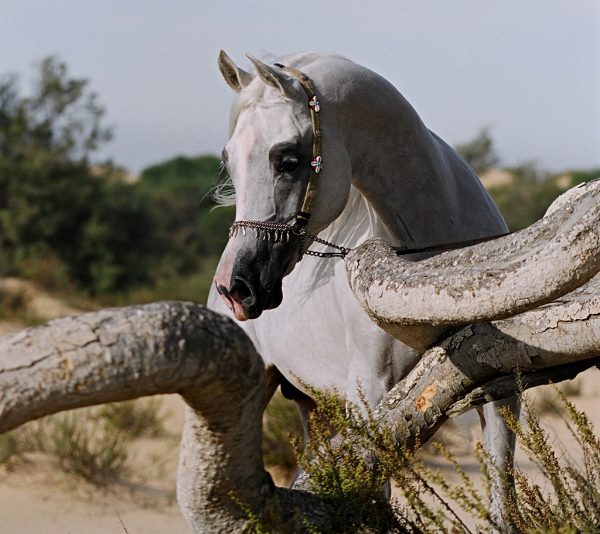
Marek Trela, Director of Stadnina Koni Janów Podlaski, and Jerzy Białobok, Director of Stadnina Koni Michałów in Poland were so impressed with the youngster that they approached Ariela about leasing him to serve as guest chief sire at Michałów in 1999 and then at Janów Podlaski the following year. One should remember that, back in the day, the idea of a straight Egyptian stallion serving as chief sire at a Polish State Stud was a novel one, to put it delicately. The opportunity being offered to such a young and still unproven straight Egyptian stallion – to cover many of the world’s most valuable pure Polish mares – sent what amounted to seismic shockwaves throughout the industry.
But the Polish Stud Directors had found in Laheeb what they thought was almost a perfect representative of the Saklawi I (Nazeer) sire line; one who both exemplified and could reproduce the Polish ideal of all that an Arabian horse should be – typey and elegant, with long harmonious lines and good movement. They could already imagine Laheeb’s potential contribution based on their past success with Palas (Aswan x Panel by Nil), a Nazeer grandson of 75% Egyptian blood, and were willing to be bold. In a 2013 interview published in Arabian Horse World, Jerzy praised the stallion, describing how “… Laheeb sired mares in the Saklawi type – very beautiful and good broodmare material.”
Although revolutionary at its time, the idea today, over two decades later, seems a given, almost patently obvious just by observing what Laheeb accomplished there. Perhaps the truest measure of his success was that, after evaluating his get, the Poles continued and continue to today to infuse Egyptian blood into their programme through sires representing the Saklawi I sire line.
Laheeb’s more famous Polish-bred get include a number of national, international, and World Champions such as his sons Poganin (ex Pohulanka by Pepton), Złocień (ex Zaleta by Piechur), and Emiliusz (ex Emocja by Monogramm), and his daughters Emira (ex Embra by Monogramm), Galilea (ex Georgia by Monogramm), Dumka (ex Dąbrowa by Probat), Wieża Babel (ex Wiazma by Arbil), Siklawa (ex Siewka by Eldon), and Eloida (ex Ekspedycja by Falsyfikat). A few precious daughters sold well at Poland’s prestigious Pride of Poland production sales, including the Janów mare Siklawa who went to Qatar and the Michałów mares Egea (ex Egna by Eukaliptus) and Ellissara (ex Ekscella by Monogramm) who went to the Kingdom of Saudi Arabia.
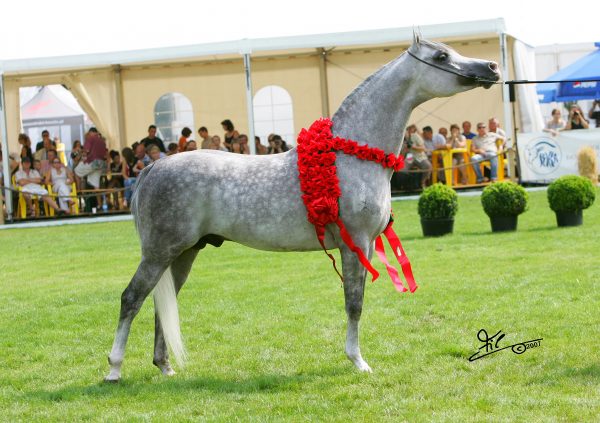
Poganin (Laheeb x Pohulanka). Credit Irina Filsinger
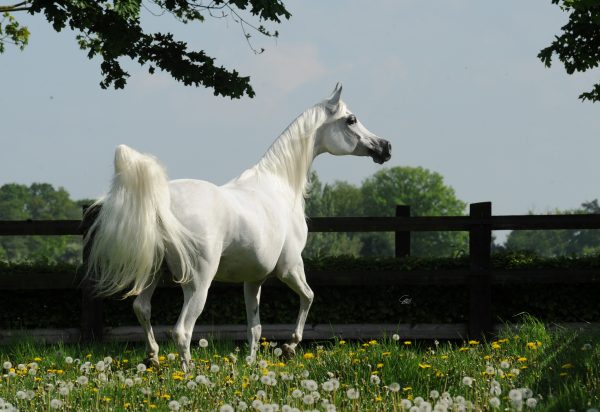
Emira (Laheeb x Embra by Monogramm). Credit Elisa Grassi
Laheeb proved so valuable in Poland that some there developed a very covetous view of him, maintaining that his true home was in Poland because only at the Polish State Studs were there enough great mares truly deserving of his attention. In fact, Michałów Stud Directors Urszula and Jerzy Białobok were impressed enough with Laheeb’s progeny to negotiate an historic lease which brought him back to Michałów for the 2008 breeding season. Unfortunately, during his second stay at Michałów most of his progeny were colts with hardly any fillies.
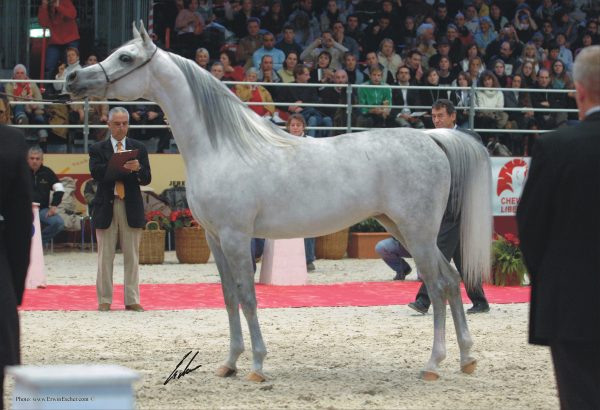
World Champion Mare Galilea (Laheeb x Georgia). Credit Erwin Escher
One might never guess by looking at him but following Laheeb’s first stay in Poland, he suffered a tragic and life-threatening accident. At just four years old, the young stallion would now face perhaps the most difficult challenge of his short lifetime. The Ariela team had decided to attempt to freeze Laheeb’s semen before his return home because the technology was not yet available in Israel, and in November 2000, Laheeb was sent to an equine centre in Germany. Tragically, a tease mare kicked him in the right foreleg, breaking the limb at the elbow. Since the actual joint was involved, it was impossible for Laheeb to bring the leg forward or to walk. His prognosis was thought to be very poor, and the German experts advised euthanasia.
Then farm manager Chen Kedar recalls how difficult it would have been for her to face seeing Laheeb in such a condition and instead sent Dr Giora Avni, the farm vet, to Germany to consult directly with the surgeons. The two firmly agreed that Laheeb should receive every possible opportunity despite the poor prognosis, and the decision was made to go forward with a very delicate surgery involving the placement of metal plates and screws into the leg at the elbow joint. If surgery succeeded, the leg would have to remain off the ground for a long time afterwards.
Following surgery and throughout the entire ordeal, Laheeb’s phenomenal character made all the difference. He demonstrated amazing courage and tolerated whatever was asked of him. A model patient, he stoically accepted the pain and the physical restraints necessary to remain immobile. Despite Laheeb’s complete cooperation, the bone itself became badly infected and once again the experts advised euthanasia, believing that the stallion would not make it.
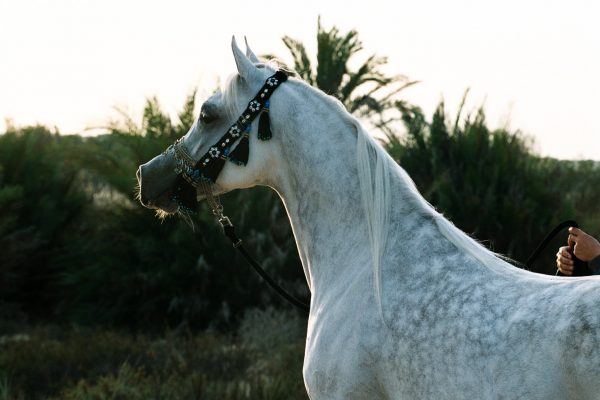
Laheeb in 2003. Credit Shira Yegar
After countless long distance calls to experts from all over the world, another fateful decision was made. “We asked the clinic not to put Laheeb down, so that a second surgery could be performed,” recalls Chen. “This time the plates were removed to let the bones knit together as best they could. Our strategy was to try to at least salvage Laheeb as a breeding horse. The final outcome would depend mostly on Laheeb’s own determination and toughness, with the added element of luck.”
Following this second surgery Laheeb spent the next several months confined in a stall, immobilised in such a way that he could neither walk nor turn around. He was also kept as thin as possible to keep weight off the affected leg.
Chen describes being shocked and extremely pessimistic when she travelled to see him. “I thought I was ready to see Laheeb in bad condition, but I could not believe it when I saw him; he was half the size he used to be. And I never saw a horse cringe so much.”
Laheeb spent about nine months at the clinic and later went to a special rehabilitation centre for another six months, where he continued to recover and underwent intense physical therapy. But no one could predict whether or not the horse would ever be sound again.
Then came a glimmer of hope. Frank phoned Chen after a visit to the clinic; he had been surprised at how well Laheeb looked. He suggested that perhaps it would be possible to show him again in the future. Chen remained sceptical and awaited Laheeb’s shipment back to Israel, which took place in May 2002.
As it turned out, Frank proved to be a good prophet and Laheeb was well enough to compete at the 2003 Israeli Nationals. Chen recalls how surreal it was to be standing once again in a show-ring with Laheeb: “… And Laheeb was there standing beside us, standing on all four legs – perfectly sound! It was an incredibly emotional, unforgettable moment for us both, and it seemed only fitting that Laheeb was the judges’ unanimous choice for 2003 Israeli National Champion Stallion.”
Part two of this feature will be published next week.
For more features from The Arabian Breeders’ Magazine, click here.


